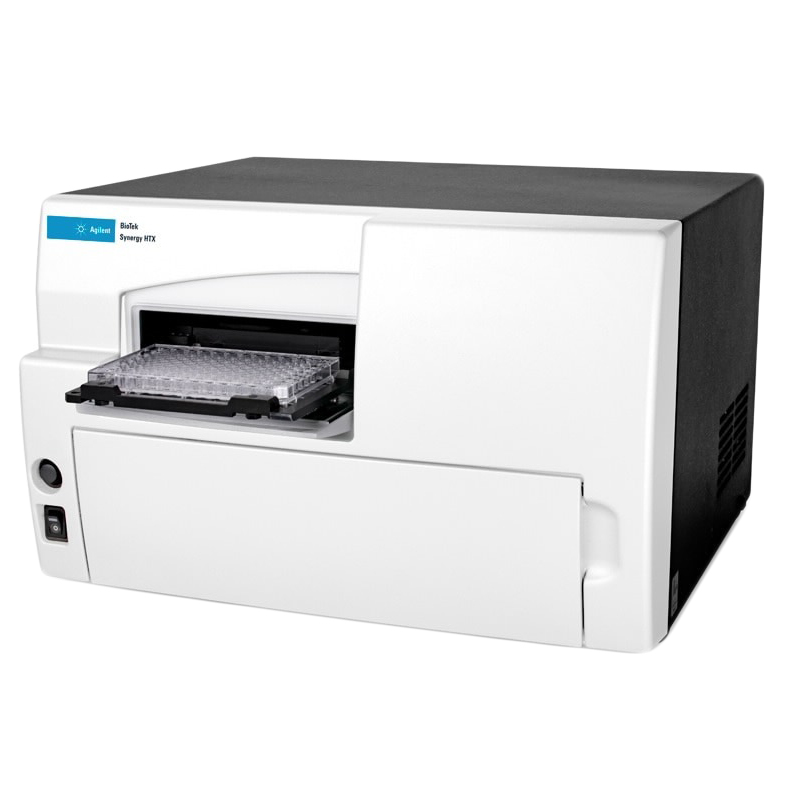 |
 |
 |
 |
Agilent BioTek Synergy HTX Multi-Mode Microplate Reader
Detection Modes
Absorbance, Fluorescence Intensity, Luminescence
Microplate Formats
6-,12-,24-,48-,96-, 384-wells
Read Types
Endpoint, Kinetic, Spectral Scanning, Well-Area Scanning
- Features UV-Vis absorbance, filter-based fluorescence, and luminescence, suitable for a wide range of end point and kinetic applications
- Equipped with a xenon flash lamp and monochromator for filter-free wavelength selection (200 to 999 nm) in absorbance measurements and a tungsten halogen lamp with interference filters for high-sensitivity fluorescence detection
- Includes Agilent BioTek’s unique 4-Zone incubation system, capable of maintaining temperatures up to 50°C, perfect for various assay requirements
- Accommodates a broad range of microplate formats, from 6 to 384 wells, providing flexibility for different experimental scales
- Controlled by the powerful Agilent BioTek Gen5 software, facilitating easy data collection, analysis, exporting, and reporting
- Compatible with the BioTek BioStack microplate stacker for automated processing of up to 50 microplates, enhancing workflow efficiency
- Suitable for nucleic acid and protein quantification, enzyme kinetics, ELISAs, genetic analysis, cell proliferation, cytotoxicity, and more
- Features cell-friendly orbital and linear shaking

The Agilent BioTek Synergy HTX Multi-Mode Microplate Reader is a versatile and high-performing instrument designed for a variety of laboratory applications. It features UV-Vis absorbance, filter-based fluorescence, and luminescence capabilities, making it suitable for a variety of different applications. The reader’s unique dual-optics design includes a xenon flash lamp and monochromator for absorbance measurements across a wide wavelength range (200 to 999 nm) and a tungsten halogen lamp with interference filters for sensitive fluorescence detection. This compact system is further enhanced with the Agilent BioTek's unique 4-Zone incubation up to 50°C, the ability to add-on dual reagent injectors, and options for linear and orbital shaking, accommodating 6- to 384-well microplates. The Synergy HTX is compatible with the user-friendly Agilent BioTek Gen5 software, streamlining data collection, analysis, exporting, and reporting.
Additionally, the Synergy HTX is designed for integration with the BioTek BioStack microplate stacker for increased automation and throughput, capable of processing up to 50 microplates simultaneously. The reader is ideal for a range of applications, including nucleic acid and protein quantification, enzyme kinetics, biomarker quantification, ELISAs, genetic analysis, cell proliferation, cytotoxicity, drug absorption and metabolism, food safety, and environmental monitoring. It's also equipped for low volume (2 μL) nucleic acid quantification with Take3 and Take3 Trio plates, and features an advanced incubator design with Condensation Control to minimize plate lid condensation. The device is alpha assay capable, modular, upgradable, and compatible with third-party automation solutions, offering convenience, versatility, and affordability for various scientific research needs.
All of our equipment is fully tested to perform at factory specifications before being shipped.
The Agilent BioTek Synergy HTX Multi-Mode Microplate Reader includes:
- > Windows 11 Professional 64-Bit Data Station with Pre-Loaded Gen5 PC Software
- > 460 nm, 528 nm, 590 nm, and 645 nm Emission Filters
- > 360 nm, 485 nm, 530 nm, and 590 nm Excitation Filters
- > ABS, FLD, LUM, and Self Test Calibration Report
- > Interface Cable
- > Operator's Manual
- > Full 180 Day Part and Labor Warranty
Agilent BioTek Synergy HTX Multi-Mode Microplate Reader Specifications
|
Absorbance Specifications
|
|
Light Source
|
Xenon flash lamp
|
|
Detector
|
Photodiode
|
|
Wavelength Selection
|
Monochromator
|
|
Wavelength Range
|
200 to 999 nm, in 1 nm increments
|
|
Monochromator Bandwidth
|
2.4 nm
|
|
Monochromator Wavelength Accuracy
|
± 2 nm
|
|
Monochromator Wavelength Repeatability
|
± 0.2 nm
|
|
Dynamic Range
|
0 to 4.0 OD
|
|
Photometric Resolution
|
0.0001 OD
|
|
Pathlength Correction
|
Yes
|
|
Photometric Linearity
|
< 1% from 0 to 3.0 OD
|
|
Photometric Repeatability
|
< 0.5% at 2.0 OD
|
|
Fluorescence Intensity Specifications
|
|
Light Source
|
Tungsten halogen
|
|
Detector
|
PMT
|
|
Wavelength Selection
|
Filter-based
|
|
Wavelength Range
|
300 to 700 nm
|
|
Dynamic Range
|
> 6 decades
|
|
Sensitivity (Top and Bottom)
|
Fluorescein 5 pM (1 fmol/well, 96-well plate)
|
|
Luminescence Specifications
|
|
Dynamic Range
|
< 6 decades
|
|
Sensitivity
|
30 amol ATP (flash)
|
|
Detection System
|
Low noise PMT
|
|
Wavelength Range
|
300 to 700 nm
|
|
Alpha Detection Specifications
|
|
Light Source
|
Tungsten halogen
|
|
Sensitivity
|
300 amol of biotinylated LCK-P peptide
|
|
Read Speed
|
2 minutes (96-well plate)
|
|
General Specifications
|
|
Microplate Formats
|
6, 12, 24, 48, 96, 384 wells
|
|
Read Methods
|
End point, kinetic, spectral scanning, well-area scanning
|
|
Plate Shaking
|
Linear and orbital
|
|
Temperature Control
|
4-Zone incubation to 50°C, ± 0.2°C at 37°C
|
|
Dimensions (H x W x D)
|
12 x 15 x 15 in. (30.5 x 38.1 x 38.1 cm)
|
|
Weight
|
27 lb. (12.3 kg.)
|
|
Electrical Requirements
|
100-240V, 50/60Hz
|
|
Computer Specifications
|
|
Processor
|
Intel Core I5-8350U CPU
|
|
RAM
|
16.0 GB
|
|
Hard Drive
|
512GB Internal SSD
|
|
Operating System
|
Windows 11 Professional, 64-bit
|
Frequently Purchased With
- Verify that the PCB and power supply output proper voltages to all internal components.
- Examine the display for brightness and clarity, replacing any dim or dead pixels to maintain optimal readability.
- Inspect all buttons for responsiveness, confirming full functionality and consistency.
- Assess the plate drawer for proper clearance and smooth operation to ensure accurate plate handling.
- Confirm seamless communication between the plate reader and computer software for data integrity.
- Inspect internal wiring and electrical connections for wear or potential faults, addressing any issues found.
- Examine the lamp, replacing it as needed to maintain proper illumination and performance.
- Execute the required validation protocol to confirm system accuracy and compliance.
- Apply all current updates to the data station and operating system to ensure compatibility and stability.
- Conduct a final cosmetic inspection to verify that all external surfaces meet appearance standards.
Technician Inspection and Recertification Checklist
The Following Checklist Is to Be Performed on All Incoming and Outgoing Equipment
| Task |
Completed? |
Remarks? |
| Verify PCB and power supply output proper voltages | Completed | |
| Check display for brightness, replace dim or dead pixels | Completed | |
| Inspect buttons for full functionality and responsiveness | Completed | |
| Assess plate drawer clearance for accurate plate handling | Completed | |
| Confirm communication between plate reader and software | Completed | |
| Inspect internal wiring and electrical connections for wear | Completed | |
| Examine lamp and replace as necessary for illumination | Completed | |
| Execute validation protocol for system accuracy | Completed | |
| Apply all current updates to data station and OS | Completed | |
| Conduct cosmetic inspection to meet appearance standards | Completed | |
To View More of Our Recertification Protocol Click Here
|
|
 |
 |
 |
 |

|

